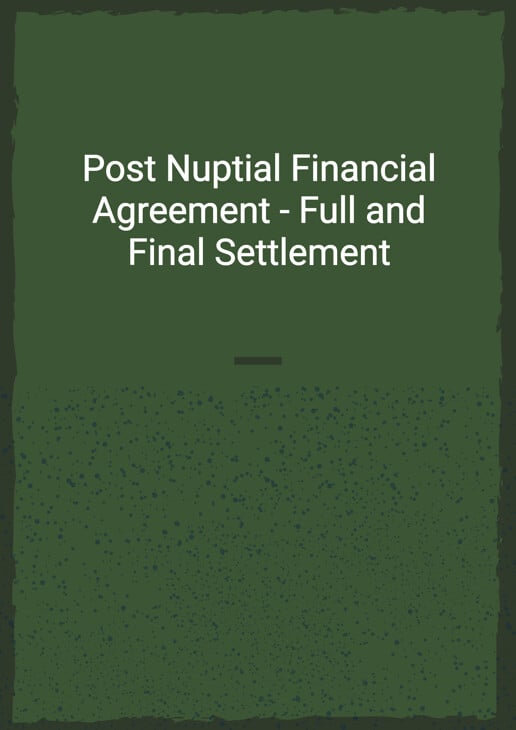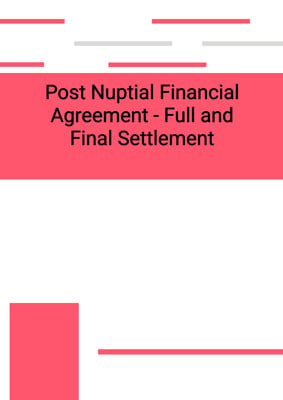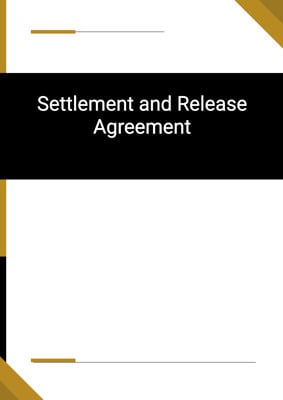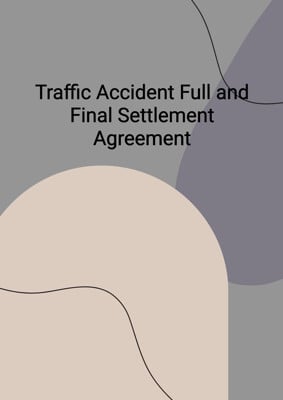
Post Nuptial Financial Agreement - Full and Final Settlement
With Children
This document can be used as a financial agreement template. This is an agreement between two parties on financial arrangement in the event that their relationship breaks down in the future. The cohabitation property to be transferred to wife.
How to Tailor the Document for Your Need?
01
Create Document
Fill in the details of the parties. You can click the "Fill with Member’s Information" button to complete it with information saved to your account.
02
Fill Information
Please fill in any additional information by following the step-by-step guide on the left hand side of the preview document and click the "Next" button.
03
Get Document
When you are done, click the "Get Document" button and you can download the document in Word or PDF format.
04
Review Document
Please get all parties to review the document carefully and make any final modifications to ensure that the details are correct before signing the document.
Document Preview
Document Description
The 'Post Nuptial Financial Agreement - Full and Final Settlement' is a legally binding document that outlines the division of property and financial resources in the event of a breakdown in the relationship between the husband and wife. It is important as it allows the parties to manage their property affairs and avoid potential litigation. The agreement is intended to be given effect by any court having jurisdiction to determine financial matters between husband and wife.
The document begins with a preamble that establishes the background of the agreement, including the lawful marriage of the parties and the harmonious nature of their relationship. It also highlights the intention of the parties to deal with the division of their property and financial resources in the event of a relationship breakdown.
The terms of the agreement are then outlined in detail. The agreement is binding upon the heirs, executors, administrators, and assignees of each party. The assets and liabilities of the parties are set out in an annexure attached to the contract, with the parties confirming their agreement with the estimated values.
The agreement includes provisions for the transfer of cohabitation property from the husband to the wife. The husband is required to do all acts and sign all documents necessary for the transfer, and the wife assumes all liabilities and indemnifies the husband against any apportionable rates, taxes, and outgoings related to the transfer.
Financial arrangements are also addressed in the agreement. The husband agrees to pay alimony or maintenance to the wife on a periodic basis, unless otherwise specified. Both parties acknowledge their financial self-sufficiency and declare that their financial status is sufficient to meet their reasonable needs.
The agreement also covers the custody of children, with provisions for joint custody, sole custody by either party, or custody by the stronger party. The parties acknowledge that nothing in the agreement bars their right to seek financial provision on behalf of any child.
Miscellaneous provisions state that the wife is entitled to the cohabitation property, insurance policies remain the sole asset of the policy holder, each party is liable for debts and liabilities in their sole name, and each party indemnifies the other from any claims or actions arising from the same.
The agreement requires each party to obtain independent legal advice before signing, and it addresses taxes, claims for provision out of the estate of a deceased party, notices, governing law and jurisdiction, and further assurance.
The agreement concludes with spaces for the parties' signatures and the names of witnesses.
The annexure to the agreement includes details of the property and agreed values, as well as a statement from the solicitor certifying that they provided independent legal advice to their client before entering into the agreement.
Overall, this document provides a comprehensive framework for the division of property and financial resources in the event of a relationship breakdown, ensuring clarity and minimizing the potential for disputes.
How to use this document?
1. Consult with a local counsel: Before using this document, it is important to consult with a local counsel to ensure that post-nuptial agreements are enforceable in your jurisdiction and to obtain any necessary legal representation.
2. Gather necessary information: Collect all relevant information, including the names and addresses of both parties, the date of the marriage, the occupations of the husband and wife, and details of any children from the relationship.
3. Understand the purpose of the agreement: Familiarize yourself with the importance of the agreement, which is to manage property affairs and avoid potential litigation in the event of a relationship breakdown.
4. Review the terms of the agreement: Carefully read through the terms of the agreement, paying attention to the binding nature of the agreement, the assets and liabilities listed in the annexure, and the provisions for the transfer of cohabitation property.
5. Consider financial arrangements: Evaluate the financial arrangements outlined in the agreement, including the maintenance or alimony payments and the declaration of financial self-sufficiency.
6. Determine custody arrangements: Decide on the custody arrangements for any children, whether it be joint custody, sole custody by either party, or custody by the stronger party.
7. Understand miscellaneous provisions: Familiarize yourself with the miscellaneous provisions, such as the entitlement to cohabitation property, the status of insurance policies, and the liability for debts and liabilities.
8. Seek independent legal advice: Before signing the agreement, ensure that both parties obtain independent legal advice from a legal practitioner regarding the effect of the agreement on their rights and the advantages and disadvantages of making the agreement.
9. Address tax considerations: Sign all necessary documents and take any required actions to minimize the burden of stamp duty or taxes and obtain any applicable roll over relief.
10. Release claims for provision out of the estate: Understand and consider the release of rights to make an application in relation to the estate of the other party, and seek court approval if necessary.
11. Communicate in writing: Ensure that all communications related to the agreement are in writing, whether delivered personally, posted, faxed, or sent by email.
12. Governed by jurisdiction state: Understand that the agreement is governed by the laws of jurisdiction state and that each party submits to the non-exclusive jurisdiction of the courts of jurisdiction state.
13. Fulfill further assurance: Commit to doing all things necessary or desirable to give full effect to the agreement, including executing any required documents.
14. Obtain signatures and witnesses: Once all steps have been completed, sign the agreement and have the signatures witnessed by appropriate individuals.
Please note that this guidance is provided for informational purposes only and should not be considered legal advice. It is recommended to consult with a legal professional for specific guidance based on your jurisdiction and circumstances.
Not the right document?
Don’t worry, we have thousands of documents for you to choose from:







